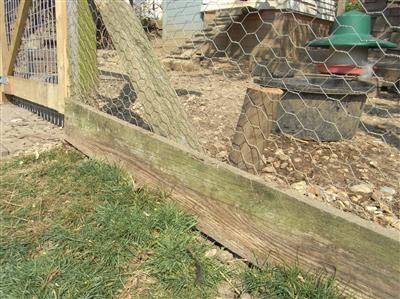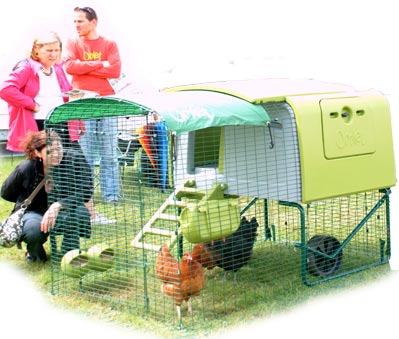There are a number of options when it comes to chicken fencing. All need to achieve two things though:
- Keep predators out (mainly the Fox in the UK but also Badgers in some areas).
- Keep your chickens where you want them.
The first is of course the highest priority to keep your chickens safe, I am happy to lose the odd plant if an escapee wanders onto the vegetable patch, this is soon forgotten about but discovering birds with their heads removed and bodies half buried is something you don’t forget for a long time, if at all.
So what are the options when it comes to fencing chickens? One of the best solutions for me has been an electric fence but this does come at a cost and requires regular maintenance. There is more information on the different kinds of electric fences on my Electric Fence page.
Chicken Wire
The good old fashioned way is to use galvanised chicken netting or rabbit wire as it is called in the trade. This needs to be at least 6 foot high and I say this because I have seen a fox leap up and scramble over the top of a 5 foot high chicken run fence when I found him inside one of my runs one morning. Wire needs to be buried in the ground about 8 inches, ideally 12 to be completely safe but if you bend the wire out, you can normally burry it 6 inches with a 6 inch overlap. If you are on sandy soil that is easier to dig, I would consider improving the depth of your chicken fencing.
Another option for securing the base further is to use boards around the base. This helps to keep any substrate inside the run (such as sand, gravel, or wood chips) but also secures the vulnerable bottom edge of the netting that is likely to get tugged and pulled at by a fox or badger and keeps the fencing rigid.
If, like me, you like your chicken run to look attractive, you can of course grow things up the outside of the fencing. I have in the past used a grape vine but the same could be done with many different climbing plants. Try to tie the plant to the wire, rather than threading it through to stop it from damaging the wire when it grows and rubs during the wind.
If chicken fencing is weak, foxes can and will tear at it to try to get in. If the wire isn’t taght or if there are weak points, don’t wait – fix it!
If you can’t find a local supplier of poultry wire – you may be able to find something suitable here.
Chicken Netting
Chicken fencing can be fairly straight forward if you are around during the daytime and don’t have a fox problem and would like to keep your chickens in a designated area. Omlet sell some chicken fencing that is a handy sized poultry netting complete with poles. This is a great idea as it allows you to easily change the shape and position of the chicken run to provide fresh pasture for them. It keeps your hens where you want them but remember this isn’t fox proof or electrified so should only be used to keep chickens in a given area when there isn’t a fox problem or when you’re around.
It is really good news for gardeners as you don’t want the chickens scratching up your beds or eating your new plants! If you turn this idea on its head, you can also use this netting to keep your chickens OFF your vegetables or garden by fencing the area off to stop them getting in!
It comes with a gate so that you can still get in and out with ease. There’s more information on the Omlet web page that you can reach by clicking the image below:







Yes, I agree with clipping one wing only and tried cutting this shorter today because I can’t see any launch pads. Will just have to hang around and see what she does. Any thoughts on the electric fence and whether that would have any lasting negative impact on a bird? Thanks
No, the electric fence is fine – these are used commercially and poultry netting does the same thing. You need a fairly powerful energizer for it to jump across the feathers to the skin and the chicken would need to be in contact with the ground (electrical path to ground).
If your fence wire isn’t buried, you would need to earth it using an earth rod (metal spike in ground) and wire connecting that to your fence.
The bird needs to be touching the wire fence and the electric wire for the current to flow from one to the other, across the bird, giving the shock (essentially a muscle spasm which feels unpleasant). They then avoid the fence after getting a shock, there is no other side effect.
Omlet chicken fencing does not work. Our chickens made holes in it within a few weeks and are able to get out. We can no longer use it. A complete waste of money. I contacted Omlet twice to tell them this but they did not bother replying. Poor customer service.
I’m not sure how that has happened. I have had mine for a number of years now and still use it when I want to keep the chickens off part of the garden. Rabbits or mice will chew it of course so maybe it wasn’t the chickens making holes?
As for customer service, I’ve never had any problems with Omlet, they have a good reputation too.
unless you’re seeing your chickens tear up the fence, my bet is that it’s rabbits chewing up. the rabbits at my place have made my plastic fencing more of a complicated gating system than fence.
We have had Omlet chicken fencing for two years now. It is used to provide extra free range space outside of their walk in chicken run. The poles do get a bit bent but our girls are happy to stay within the enclosure.
How often do I need to clip the wing, to keep them off balance?
The feathers regrow after a moult which is normally only once per year. You need to leave them alone while growing (they will be filled with blood) and clip afterwards.
Hi
What a great website. I’ve read your advice as we are just about to build a chicken pen around our apple tree orchard. It will be approximately 10m X 24m square. It’s in a field and we have foxes and badgers in the area. We plan to dig down a foot to bury the wire.
There are such a variation of wires. Can you advise on the gauge we need please?
Many thanks
Kelly
I would try to go for the best you can afford. British manufactured wire from a farmers outlet is usually the strongest. If you are concerned, I would bury the first length a foot and then overlap the top of it with the next length so that the bottom 3ft or so is doubled up. Badgers are incredibly strong but only tend to be a problem at night so locking up your chickens in the coop is the safest. If you have real problems then an electric fence is the only way to really stop them, without using weld mesh!
Thank you. I’ve just found some but then realised as its only 3 foot high how do you secure the bottom layer to the next layer?
We are using scaffolding poles and cable ties to fix the wire on.
Any suggestions would be appreciated as we really want to get this right!
Many thanks
Kelly
When joining netting, I overlap it and use a single galvanised wire to nit it together. I pass it back and forth every 3 to 4 holes. If it’s a long section of wire, it can be hard pulling the wire through so make sure you pull enough through to allow you to reach the end with spare.
How did it go with the scaffolding? I’ve had the same idea and about to start the design 🙂